Rooms 11-16
These room probably belonged to the last phase of the expansion of the palace, which began in 1582 under Valentino Martelli.
Room 11
St Antony of Padua Polyptych (ca. 1468)
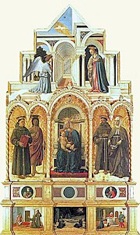
The nuns removed the altarpiece from this altar in 1608, and it was documented soon after in the sacristy. It was moved to the altar of the inner church in 1668 (where it replaced an altarpiece by Raphael that the impoverished nuns had been forced to sell). It was confiscated in 1798, returned soon after, but transferred definitively to the Accademia di Belle Arti in 1810. Two of the predella panels were subsequently dispersed but later returned to Perugia. The altarpiece was recomposed in the gallery in 1921.
The figures in the main register occupy a unified space behind the framing, and are set against a backdrop of golden brocade. They depict:
-
✴the Madonna and Child enthroned (in the central panel);
-
✴SS Antony of Padua and John the Baptist (to the left); and
-
✴SS Francis and Elizabeth of Hungary (to the right).
The magnificent panel in the upper storey depicts the figures of the Annunciation in front of an arcade that appears to be a mathematical study in perspective. It is possible that this part of the altarpiece was originally intended to be rectangular, but that it was cut into a cusped shape to harmonise with the Gothic apse in which the altarpiece was placed.
The altarpiece has a double predella:
-
✴The upper predella panel contains half length images in tondi of SS Clare (to the left) and Agatha (to the right). It seems that the empty central panel of the predella was hinged so that the priest could serve the Eucharist to the sisters in the inner church.
-
✴The lower predella panels depict scenes involving the Franciscan saints in the main register:
-
•St Antony raising a child from the dead;
-
•the stigmatisation of St Francis; and
-
•St Elizabeth saving a boy from drowning in a well.
Madonna and Child (ca. 1460)
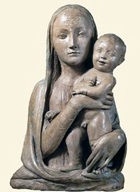
Room 12
Gonfalon dell' Annunziata (1466)
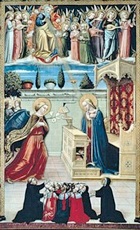
The central part of the banner depicts the Annunciation, set inside the palatial home of the Virgin. God the Father, who sits on a throne above that is formed by the wings of seraphim and surrounded by an angelic orchestra, sends the Holy Spirit towards the Virgin in the form of a dove. Below, SS Philip Benizi and Juliana Falconieri recommend a group of worshippers to the Virgin. (Neither had been canonised at the time that the banner was painted, and they are shown in their Servite habits with the rayonant haloes appropriate for the beatified.)
Prominent among the group of worshippers are members of the Collegio dei Dottori Legisti (the college of doctors of law): they are known to have walked in procession to the Servite church on the Feast of the Annunciation, and they were probably associated with the commission of the new banner. The group also includes members of the penitent confraternity, at least one Servite friar, and a group of pious women, most of whom wear Servite habits.
Burial of Christ (1432)

Panels from a triptych (late 1460s)
The three panels, which are attributed to Giovanni Francesco da Rimini (a follower of Piero dell Francesca), were documented in the late 18th century in the sacristy of San Francesco al Prato. They passed to the Academia di Belle Arti in 1810 and to the gallery in 1863.

-
✴the Madonna and Child;
-
✴St Francis; and
-
✴St Jerome.
The inscription on the base of the throne identifies the commissioner as Luca Alberto di Francesco.
Room 13
Frescoed aedicule (1488)
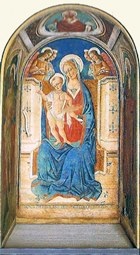
-
✴the Madonna and Child;
-
✴St Sebastian on the left;
-
✴St Antony Abbot on the right; and
-
✴God the Father above.
The scroll in the left of the throne bears the signature of Matteo da Gualdo, and the inscription below the Virgin also has a date, which is probably 1488 (although it could be 1493).
Room 14
Madonna and Child with angels (ca. 1450)
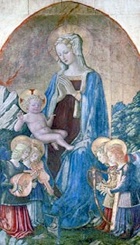
This panel is sometimes associated with payments made to Benedetto Bonfigli and Bartolomeo Caporali in 1467-8 according to the will of a merchant, Francesco di Pietro for an altarpiece for the Cappella di San Vincenzo Ferreri. However, this work would almost certainly have included a figure of St Vincent: that does not rule out a polyptych with the present panel at its centre, although, given its size, the panel was more likely to have been an independent altarpiece.
The panel depicts the praying Madonna against a rocky landscape. Vertical lines to either side of her suggest the back of a throne. The baby Jesus reclines confidently on her lap, holding Himself in place by clutching her gown, while four kneeling angels to the sides play various musical instruments.
Madonna and Child with saints and angels (ca. 1450)
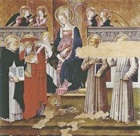
The panel depicts the Madonna and Child enthroned with SS Thomas Aquinas, Jerome (with his lion), Francis and Bernardino in front of a low parapet, behind which stand four praying angels. It is odd that the most prominent of these saints is the Dominican, St Thomas, to whom the baby Jesus passes a bright object that is an allegory of his teaching. Each of the saints holds a book, but that of St Thomas is open, revealing the words that Christ spoke to him as he prayed before a Crucifix: “Bene scriptisi de me Thoma ...” (You have written well of me Thomas ...).
Annunciation with St Luke (ca. 1450)
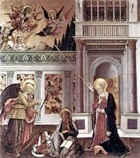
The co-patrons of the guild were the Virgin Annunciate and St Luke, and this determined the subject of the altarpiece. The Annunciation is set in a Renaissance palace, presumably intended to represent the Virgin’s home. God the Father in a mandorla of seraphim appears against a golden sky above a rocky landscape, surrounded by flying angels, and sends the Holy Spirit towards the Virgin in the form of a dove. St Luke (with the ox that is his usual attribute) squats between the Virgin and the angel Gabriel and records the miracle for his Gospel, as a good notary would. The original predella, which depicted the Pietà with SS Mark and Jerome, still survived in 1822 but was subsequently lost.
Adoration of the Magi (ca. 1466)
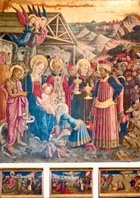
-
✴one of which depicted the Adoration of the Magi; and
-
✴the other of which depicted "many saints".
This altarpiece, which is presumably the first of these, was first recorded in 1548 in the Cappella dei Magi of San Domenico. The merchant, Nicolò di Gasparo di Lello commissioned the chapel in 1464-6, and it seems likely that he also commissioned this altarpiece for its altar.
Like many works in San Domenico, the altarpiece was probably removed from its original location after the collapse of the vaulting of the nave in 1614. It was recorded in the convent in 1683 and in the church in 1712. Although it was listed among the works to be sent to the Musei Capitolini, Rome in 1812, it was subsequently decided that it should remain in the church. It was transferred to the gallery in 1863.
In the main panel, the three kings present their gifts to the baby Jesus, who is on the lap of the Madonna and flanked (as in a conventional sacre conversazione) by SS John the Baptist and Nicholas of Bari (the name saint of the presumed donor). The figures are placed in front of the crumbling stable, which is set in a rocky landscape outside the walled city of Bethlehem.
The predella panels depict:
-
✴the baptism of Christ by St John the Baptist;
-
✴the Crucifixion; and
-
✴a miracle of St Nicholas of Bari.
Gonfalon of San Bernardino (1465)
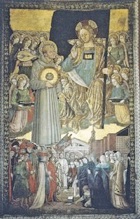
The banner depicts St Bernardino, with his usual attribute of a rayonant disc proclaiming the holy name of Jesus (“IHS”), commending the citizens of Perugia to Christ. He sits in judgement, surrounded by a choir of angels. The citizens are depicted donating candles on the feast of St Bernardino. The bishop blesses the assembly, which includes the leading civic officials and their ladies as well as a number of Franciscan friars and nuns. A small boy is about to steal one of the candles, and the inscription on his sleeve shows a black devil with a warning : “fura che serai apeso” (if you steal, you will hang).
The citizens are assembled in the Piazza di San Francesco, presumably at the end of the annual procession. Behind them is the facade of the Oratorio di San Bernardino, which had been completed only four years earlier. The image of San Francesco al Prato to the right provided important evidence for the original appearance of its facade that facilitated its restoration in 1926.
Angels offering roses (ca. 1464)
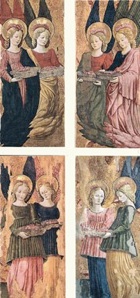
-
✴One pair came from the Oratorio dei SS Andrea e Bernardino in 1863.
-
✴Cappella del Gonfalone, San Francesco al Prato in 1909, the year in which the chapel was closed.
Modern scholarship has determined that the panels were originally arranged in pairs, one above the other, and that they probably decorated two sides of a tabernacle. All of the angels would have looked inwards towards whatever was housed in the tabernacle: the presence of two of the panels in the Cappella del Gonfalone suggests that this was probably the Gonfalon di San Francesco al Prato (1464), which is also attributed to Benedetto Bonfigli. This banner, for which the chapel was built, is now in the Oratorio di San Bernardino.
Room 15
Madonna and Child with angels (1465)
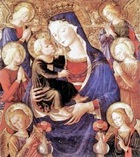
The panel depicts the half length Madonna and Child against a golden brocade backdrop with six angels, two of which hold vases of roses. The Madonna wears a crown and the baby Jesus is clothed (perhaps at the request of the nuns) in a sumptuous gown of what seems to be green velvet lined with red silk.
Miracles of St Bernardino (1473)
A group of artists known as the Workshop of 1473 is named for these eight panels, which depict miracles of St Bernardino of Siena. They are dated by inscription (above the arch of Titus in the panel on the bottom left below): they were first recorded in 1784 in the sacristy of San Francesco al Prato (link below) and subsequently moved to the gallery:
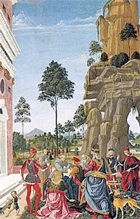
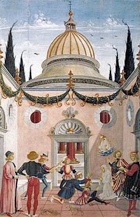
St Bernardino restores to life St Bernardino heals Giovanni
a man found dead under a tree Antonio da Parma, who has been
wounded by a nail in his head
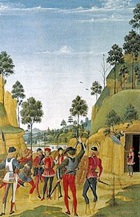
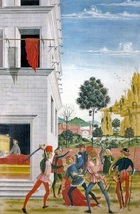
St Bernardino posthumously St Bernardino posthumously heals the
liberates a man who has been wounds of Giovanni Antonio Tornano,
unjustly imprisoned who has been hurt in an ambush
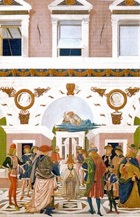
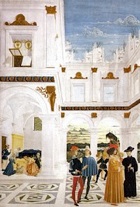
St Bernardino posthumously ** St Bernardino restores to life
restores the sight of a blind boy a baby that has died at birth
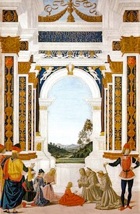
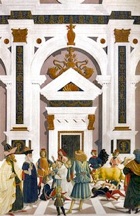
St Bernardino cures the daughter of ** St Bernardino revives Nicolò di
Giovanni Antonio Petrazio da Rieti Lorenzo da Prato, who has been
of an ulcer trampled by a bull
History of the Panels
As noted above, these panels were first recorded in 1784 in the sacristy of San Francesco al Prato. They were said to have been “sawed” from a niche that had housed a statue of St Bernardino.
The panels were removed from Perugia after the Napoleonic suppression 0f 1810:
-
✴Dominique-Vivant Denon, the Director of the Musée Napoleon (later the Musée du Louvre) selected two of them (marked ** above) for confiscation in 1812, and they were duly shipped to Paris. Antonio Canova recovered them in 1815.
-
✴Agostino Tofanelli, the Director of the Musei Capitolini, took the other six to Rome.
They were all returned to San Francesco al Prato in 1817, and transferred to the Galleria Nazionale in 1863, together with a panel depicting the trigram “IHS” which came from the top of the niche.
The panels were restored in 1991-3, and it was during this work that it was confirmed that they had originally been painted on two planks (four scenes on each) that decorated the vertical sides of a niche. Technical analysis has allowed the original order of the panels to be established, as set out above.
Provenance and Attribution
These panels are among the earliest surviving works in Perugia that fully reflect the aesthetic of Renaissance Florence and of the courts at Urbino and Rimini, and it is surprising that they went unrecorded for so long. They were almost certainly commissioned in response to the translation of the relics of St Bernardino to the new church of the Observant Franciscans in Aquila in 1472. The scenes depicted were derived from the “Lo Specchio de l’ Ordine Minore” (otherwise known as “La Franceschina”), which was published by the Observant Franciscan Giacomo Oddi of Perugia in ca. 1474.
Candidates for the original location of the niche in which the panels were mounted include:
-
✴the Oratorio di San Bernardino; and
-
✴the Cappella di San Bernardino (now the Cappella del Santo Anello) in the Duomo.
At the time that the panels were first recorded, they were attributed to Pisanello (died 1455), and this attribution accompanied them when they were confiscated in the 19th century. This error was first noted at about the time that they were returned to Perugia.
It is generally agreed that the panels were conceived as part of a coherent program by a single designer, but that a number of individual artists were involved in their execution. The identities proposed for these artists have varied over time. Recent scholarship, as summarised in the reference below, suggests that the designer was most probably Bartolomeo Caporali:
-
✴the attribution of the top two panels on the right to Pierantonio di Nicolò del Pocciolo is made on the basis of miniatures (1472) in an antiphonary from the Abbazia di San Pietro that are securely his work (see Schedules 7 and 8 in the catalogue referenced below).
-
✴the bottom two panels on the right attributed to Sante di Apollonio; and
-
✴the young Pintoricchio is generally held to have contributed to the panels on the left, along with Perugino and/or Fiorenzo di Lorenzo.
Triptych of Justice (1475-6)
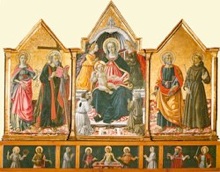
This triptych from the Oratorio dei SS Andrea e Bernardino was generally attributed to Fiorenzo di Lorenzo until Michael Bury (see the page on either artist) discovered a document in the archives of the Confraternita di Sant' Andrea della Giustizia that records its commission from Bartolomeo Caporali and Sante di Apollonio del Celandro. The altarpiece was originally in the confraternity's church of Santa Mustiola, and it moved with the brothers to the Oratorio di SS Andrea e Bernardino in 1537. It was given to the Commune before 1872 and entered the gallery in 1895.
-
✴In the central panel, two members of the confraternity kneel before the Madonna and Child, who are flanked by a pair of angels.
-
✴The side panels depict:
-
•SS Mustiola and Andrew; and
-
•SS Peter and Francis.
-
It is significant that St Mustiola holds the Virgin’s wedding ring, because this relic (the Santo Anello), which had long been associated with Santa Mustiola at Chiusi, had been stolen in 1473 and brought to Perugia. (It is now in the Cappella del Santo Anello in the Duomo).
-
✴The predella depicts:
-
•SS Bernardino and John the Baptist, on the left;
-
•the Pietà with the Virgin and St John the Evangelist at the centre, flanked by another two members of the confraternity; and
-
•St Jerome and a soldier saint on the right.
Adoration of the Magi (ca. 1470)
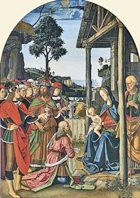
The attribution to Perugino is supported by the fact that the face of the young man on the extreme left, who wears a red cap and looks at the viewer, seems to be a self-portrait. Dating to the early 1470s is supported by the fact that the face of the king with the green cloak was re-used for St Roch in a fresco (1476 or perhaps 1478) that is dated by inscription and also attributed to Perugino, which came from San Francesco, Deruta. It therefore seems likely that this was among Perugino’s earliest important commissions in Perugia.
The Madonna and Child are depicted at the entrance to the stable with the aged St Joseph to the right. The baby Jesus blesses the oldest of the three kings, who kneels before Him, while the other two kings and their courtiers stand to the left. All of the male faces seem to be portraits, probably of members of the noble family that commissioned the work (possibly the Baglioni) and their associates. The scene is set in a rocky landscape.
Madonna and Child with angels (1470s)
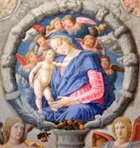
Room 16
Figures of the Annunciation (1467-8)
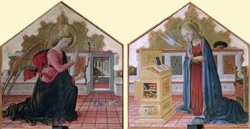
Giorgio Vasari referred in 1568 to two altarpieces in San Domenico by Benedetto Bonfigli:
-
✴one of which depicted the Adoration of the Magi (see above); and
-
✴the other of which depicted "many saints".
This second altarpiece was probably associated with a payment made to Benedetto Bonfigli and Bartolomeo Caporali in 1467-8 according to the will of a merchant, Francesco di Pietro for an altarpiece for the Cappella di San Vicenzo Ferrer (the 2nd on the left in the nave).
Four panels that probably belonged to this second altarpiece were moved from the sacristy of San Domenico to the Galleria Nazionale in 1863:
-
✴Two panels of the figures of the Annunciation (illustrated above), which are attributed to Bartolomeo Caporali, are exhibited here. The proposed dating is supported for the first two panels by the fact that some of the details of the Virgin’s study seem to have been inspired by the Gonfalone dell’ Annunziata (1466), which is attributed to Nicolò Liberatore, l’ Alunno and which is now now in Room 12 of the gallery.
-
✴Two panels of pairs of saints, which are attributed to Benedetto Bonfigli, are now in the deposit of the gallery. They might have flanked a central figure of St Vincent Ferrer, thus justifying Vasari's description.
Madonna della Misericordia (1476)
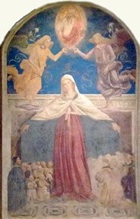
The fresco depicts the Virgin sheltering members of the Collegio della Mercanzia (who owned the hospice) and inmates from the hospice under her cloak. The large figure to the left is probably Canon Galeotti. God the Father looks down as two angels appear to crown the Virgin: it is likely that they originally held a golden crown that has been lost.
St Sebastian (ca. 1476)
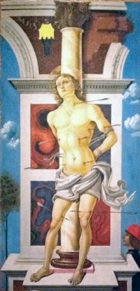
Panels from the polyptych of the Sylvestrines (1487-93)
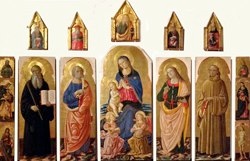
A series of three contracts between the Sylvestrines of Santa Maria Nuova and Fiorenzo di Lorenzo relate to this work:
-
✴The first, dated 1472, documents the commission of a double-sided polyptych.
-
✴The second, dated 1487, reduces the scope of the commission to a single-sided polyptych.
-
✴The third, dated 1491 (when the work seems to have been in progress), requires that the project should be completed by 1493.
This polyptych remained in the church when the Sylvestrines left in 1540. It had almost certainly been originally on the high altar, but it had been moved by the early 17th century. It was probably dismantled in 1810, when it was moved to the Accademia di Belle Arti.
The original frame and the predella panels have been lost.
-
✴The five main panels depict:
-
•the Madonna and Child with two kneeling angels;
-
•St Peter;
-
•St John the Evangelist;
-
•St Benedict; and
-
•a Sylvestrine saint (St Sylvester Gozzolini or the Blessed Paolino Bigazzini, both of whom were included in the agreed scope of the work before it was reduced in 1487).
-
✴The pilasters contain figures of:
-
•a Benedictine monk, the Archangel Gabriel and St John the Baptist (on the left); and
-
•a Benedictine monk, the Virgin Annunciate and St Sebastian (on the right).
-
✴The smaller panels from the upper register contain figures of God the Father and the Doctors of the Church (SS Ambrose, Jerome, Augustine and Gregory).
Niche from San Francesco al Prato (1487)
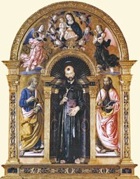
The polygonal niche, which contains an inscription that refers to St Francis as a venerated servant of the Church, is surrounded by painted panels inside a larger Renaissance frame. The panels depict:
-
✴the Madonna and Child in a mandorla of cherubs and two praying angels (above);
-
✴St Peter (to the left); and
-
✴St Paul (to the right).
The signature of Fiorenzo di Lorenzo and the date appear on the hems of the robes of the Apostles.
The predella panel contains small tondi of Franciscan saints:
-
✴St Bonaventure (who had been canonised in 1482, only five years before the panel was painted);
-
✴SS Bernardino of Siena and Antony of Padua; and
-
✴St Louis of Toulouse.
Madonna and Child (15th century)
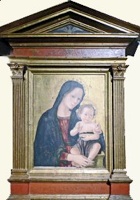
Panels from a polyptych (late 15th century)
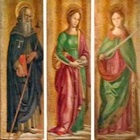
-
✴St Antony Abbot;
-
✴St “Dignamerita”; and
-
✴St Catherine of Alexandria .
The name “Dignamerita” is a reference to the Roman martyrs recorded as SS Digna and Emerita, who were possibly a single person. The figure in this panel holds a fish with a ring in its mouth, for reasons that are now unclear.
Galleria Nazionale: Sala Podiani and Sala Conferenze Rooms 1-3 Room 4
Rooms 5-6 Rooms 7-10 Rooms 11-16 Room 17 Rooms 18-20 Cappella dei Priori
Rooms 22-28 Rooms 29-32 Rooms 33-40 Deposit
Return to Museums of Perugia.
Return to Walk I.



